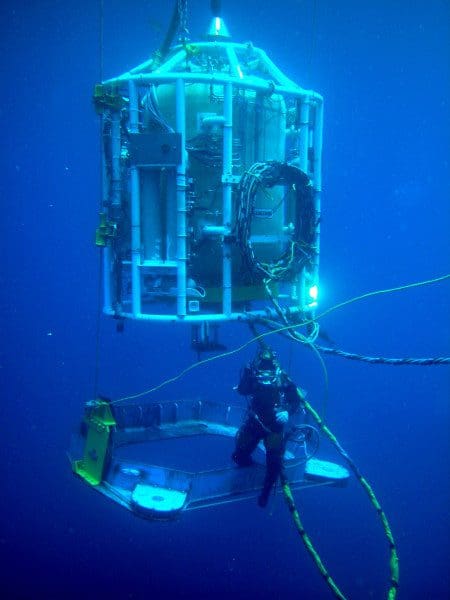 A diving bell, also known as a wet bell, is a cable-suspended airtight chamber, open at the bottom like a moon pool structure, that is lowered underwater to operate as a base or a means of transport for a small number of divers. The pressure of the water keeps the air trapped inside the bell. They were the first type of diving chamber. Unlike a submarine the diving bell is not designed to move under the control of its occupants, nor to operate independently of its tether.
A diving bell, also known as a wet bell, is a cable-suspended airtight chamber, open at the bottom like a moon pool structure, that is lowered underwater to operate as a base or a means of transport for a small number of divers. The pressure of the water keeps the air trapped inside the bell. They were the first type of diving chamber. Unlike a submarine the diving bell is not designed to move under the control of its occupants, nor to operate independently of its tether.
Diving bells are used as underwater rescue vessels and by commercial divers doing underwater work and salvage. The bell is lowered into the water by cables from a crane attached to a ship or dock. The bell is ballasted so as to remain upright in the water and to be negatively buoyant so that it sinks even when completely full of air.
- Hoses, fed by pumps on the surface, provide compressed breathing gas to the bell, serving two functions:
- Fresh gas is available for breathing by the occupants, and excess gas leaks out under the lip of the wet bell, where it bubbles naturally to the surface.
As a wet bell is lowered, increasing pressure from the water compresses the gas in the bell. If the gas pressure inside the bell were not raised by adding gas to compensate for the outside water pressure, the bell would partially fill with water as the gas was compressed. Adding pressurized gas ensures that the usable workspace within the bell remains constant as the bell descends in the water, as well as refreshing the air, which would become saturated with a toxic level of carbon dioxide and depleted of oxygen by the respiration of the occupants.
A similar principle to that of the wet bell is used in the diving helmet of standard diving dress, where compressed air is provided to a helmet carried on the commercial diver’s shoulders. Additional weights are carried on the waist and feet to prevent overturning. The modern equivalent of this diving equipment is used in surface supplied diving.
A wet sub may also provide a dry viewing chamber for the operator’s head, acting as would a diving helmet.
The physics of the diving bell applies also to an underwater habitat equipped with a moon pool, which is like a diving bell enlarged to the size of a room or two, and with the water–air interface at the bottom confined to a section rather than forming the entire bottom of the structure.
“Diving Bell” from Wikipedia.com
